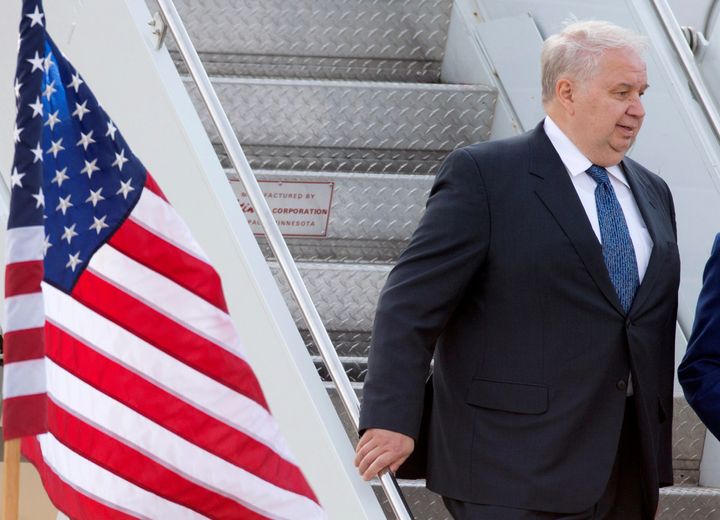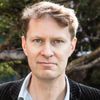
He is Russia’s most famous ambassador. In the spring, summer and autumn of 2016 Sergei Kislyak – Moscow’s long-time envoy to the United States - was a ubiquitous figure. He met with Jared Kushner, Michael Flynn, Carter Page and Jeff Sessions. All of whom subsequently struggled to remember these encounters, as if they had happened in a magical fog. He attended the Republican party convention in Cleveland. A large, avuncular-looking figure with snow white hair, his frame filling out his jackets, he was hard to miss.
In May 2017 the ambassador met President Trump in the White House, together with Sergey Lavrov, Russia’s veteran foreign minister. The previous day Trump had fired FBI chief James Comey. This, Trump told his visitors, had “taken off” the pressure he felt over Russia. Comey was “a nut job”. Trump’s optimism was misplaced. The meeting, nevertheless, was warm: handshakes, smiles, and photographs taken not by an American but by the Russian foreign ministry’s official photographer.
When I was writing my new book on Trump and Russia – Collusion – something in Kislyak’s biography struck me as odd. There was no mention of his parents. Merely a line that he came from a Soviet “Ukrainian family”. Who were they? I made inquiries. Sources – in Ukraine and elsewhere – reported back. Missing from Kislyak’s CV was a sensitive detail. Kislyak’s father, Ivan Petrovich Kislyak was a legendary spy and KGB officer. He retired from intelligence work as a KGB major general.
The Kislyaks were indeed Ukrainian. Ivan Petrovich was born in the village of Terny, in the Poltava region of Soviet central Ukraine. He came from humble origins. Ivan’s father - Kislyak’s grandfather - worked in the local sugar factory. The family lived in a modest wooden house on Sovietskaya ulitsa, Soviet Street.
In the 1940s, Ivan Petrovich took part in operations against Ukrainian nationalists fighting the Red Army. After the war, he joined the MGB, the forerunner to the KGB. In 1949 he was assigned to the personal bodyguard of Lavrenti Beria, Stalin’s brutal and depraved security chief. Sergey Kislyak was born in Moscow a year later.
According to my sources, Kislyak Senior gained a reputation inside the service for good fortune. He was moved to other duties two years before Beria was arrested in the summer of 1953. Beria was secretly tried, and executed. The KGB later sent Kislyak to western and southern Europe: to Greece, Portugal, France, and Spain. His codename was Maisky. (This was the name of Stalin’s famous ambassador to London, Ivan Maisky, whose diaries are an invaluable source of information on British foreign policy during the appeasement and early war years).
“Was Sergei Kislyak - like his father before him - a spy?”
I consulted the the KGB’s records. A disgruntled foreign service archivist, Vasili Mitrohkin, had taken them to England soon after the collapse of the Soviet Union. Ivan Petrovich received several mentions. I learned that he specialised in secret operations: sniffing out, on Moscow’s instructions, a new generation of agents from inside the Greek communist party, for example. (They had to possess “charm” and be “totally reliable ideologically,” Kislyak said.)
Kislyak’s career was subterranean. But in many respects it anticipated his son Sergei’s later, more public role in influencing and shaping US politics. Both father and son were loyal servants of Moscow. Between 1972 and 1977, Ivan Petrovich served as the KGB’s station chief in Paris. He presided over a large number of secret agents—including a cipher clerk working deep inside the French foreign ministry. He co-ordinated “active measures” to ramp up US–French tensions. His KGB residency even claimed to have steered the editorial pages of Le Monde.
Did Kislyak Sr work for the KGB in America? Maybe. In August 1982, Kislyak went back to his home village of Terny to attend a school reunion, taking Sergei—his diplomat son—with him. By this point, Sergey Kislyak was living in New York and was attached to the Soviet mission to the United Nations.
Local historian and resident Anatoly Lesnoy met both Kislyaks in Terny. Ivan refused to take part in the reunion photo—“pictures were forbidden,” he said—but a blurry snap of him exists. Lesnoy told me that Ivan spoke perfect English, as well as Ukrainian and Russian. He had flown in together with his son from New York. “He was a very pleasant person. We are proud of him,” Lesnoy said of the older Kislyak. After New York, Kislyak served another four years in Washington at the Soviet embassy. He got to know America well. Kislyak’s duties - in the 1990s he served in Brussels and Moscow - meant that he never went back to the family’s home Ukraine. The Kislyaks’ Soviet Street house was demolished in the early 1990s. Only a fir tree in the garden remains.
Was Sergei Kislyak - like his father before him - a spy? The answer was, probably not. Generally the sons of high-ranking KGB officers joined the Soviet foreign service rather than the KGB.
At the same time Kislyak would likely have been fully cognizant of the Kremlin’s efforts to help Trump during the 2016 US presidential election. He would also have been aware of the KGB’s covert activities in the United States in the 1980s, from a generation earlier, directed out of missions in both Washington and New York. As James Clapper put it, the former director of national intelligence put it, Kislyak oversaw “a very aggressive intelligence operation.” Moscow had more US-based spies than any other country. “To suggest that he is somehow separate or oblivious to that is a bit much,” he added.
To what extent did Kislyak agree with Vladimir Putin’s aggressive strategy in 2016, to meddle in American politics to the benefit of candidate Trump? We can’t fully know. According to the dossier by the former British intelligence officer Christopher Steele, however, Kislyak was part of a cautious Kremlin faction that warned of “the potential negative impact on Russia” from the operation to aid Trump during the 2016 race. Those of a similar conservative mind included Yuri Ushakov, Kislyak’s predecessor in Washington and a presidential adviser, and the Ministry of Foreign Affairs, the dossier said.
Whatever Kislyak’s private misgivings, he carried out his duties energetically. When Trump gave a foreign policy speech in April 2016 in Washington, Kislyak sat in the front row. He met the candidate. He talked to Trump’s future national security adviser, his son-in-law, his foreign policy aides.
To understand the extraordinary events of 2016 you have to go backwards - to the Cold War, and to the decades when Ivan Petrovich Kislyak carried out influence operations, from deep inside the enemy countries of western Europe. The methods are the same, the goals similar. Only this time the latest leader in the Kremlin is winning and the west losing.
Collusion: How Russia Helped Trump Win The White House by Luke Harding is out now (Guardian Faber, £14.99)
